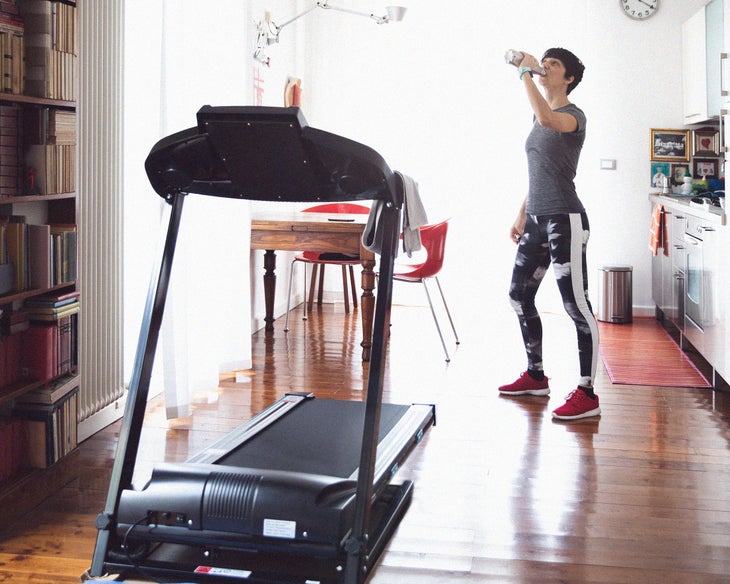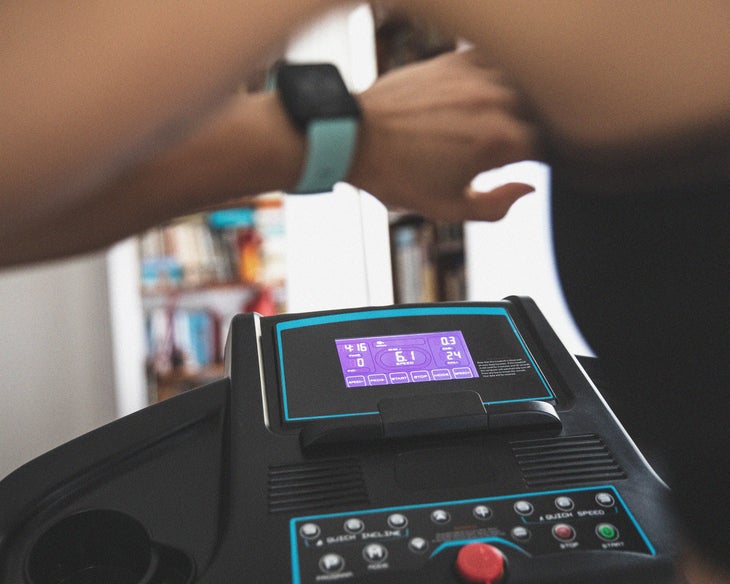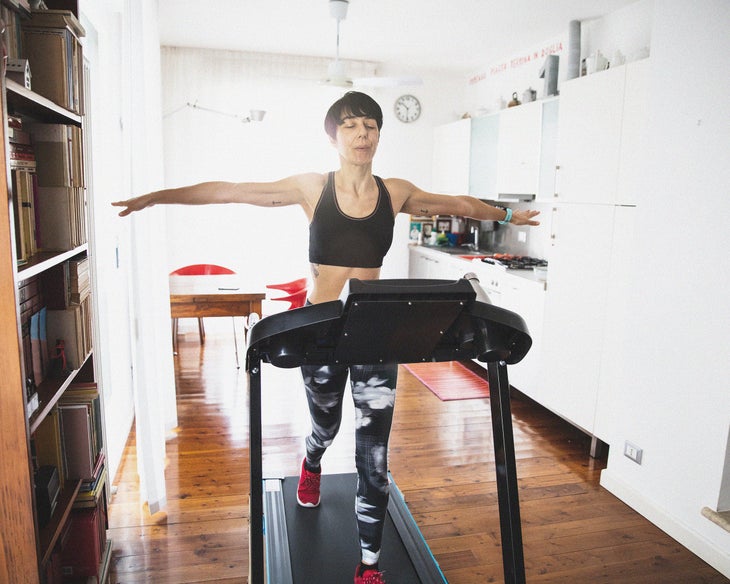Products You May Like
Get access to everything we publish when you
sign up for Outside+.
At some point in every runner’s life, they’ll be faced with a decision: run in the freezing rain, sleet, snow, negative temperatures, head to the gym to use a treadmill, or don’t run at all.
If we land on the “head to the gym” option, things can get dicey. After all, how many of us have said we’ll leave for the gym in “just a second,” only to be drawn into our phones and couch, then look up and realize it’s hours later? Yeah. Pretty much all of us.
Having a treadmill in your home is one of the best ways to maximize your consistency and efficiency as a runner. It makes the decision easy on tough days: no heading out into nasty weather, no procrastinating a drive to the gym—just grind it out right from the comfort of your own home.
But how to choose a treadmill to purchase is a whole word unto itself. There are different belt widths, incline/decline abilities, interactive screens, payment plans, and it can quickly become overwhelming.
Tracy Green has run 15 marathons since 2006 and is an assistant coach with Personal Best Coaching, a training group in Louisville, Kentucky. “I believe exercise should be fun and accessible to everyone,” she says. “I use a treadmill for lots of different reasons: weather, time constraints, safety concerns, workout logistics, or just because I feel like watching some TV while I run.”
Green is in the camp of a run is a run is a run. And while she maintains that mixing in outdoor runs when training for a race is important, a treadmill can be an excellent addition to your exercise regimen.
RELATED: The Runner’s Guide to Building a Better Home Gym
Top Things to Consider When Choosing a Treadmill
If you’ve decided to take the plunge on buying a treadmill, here’s how to choose a treadmill that’s right for you.
Your Budget
The first place to start when looking at a treadmill for your home gym is budget. Treadmills can range from around $600 all the way to just under $8,000. As you can tell, that’s quite a range.
The less-expensive treadmills tend to be very basic: no touch screen, limited speeds and grades, and a narrower, less-cushioned belt. On the opposite end, the pricier models will usually include a touch screen with pre-programmed training options (some treadmills like NordicTrack even have their own training apps), the ability to both incline and decline, a wider range of speeds, and a quieter, cushioned belt.

Just because your budget may be on the lower end does not mean you should immediately opt for the cheapest treadmill you can find, especially if you are a daily runner or training for a long-distance event.
Many fitness equipment companies now offer payment plans on their treadmills for sometimes as low as $10–15 per month for qualified buyers. Take time to consider your budget and what a reasonable monthly payment could look like for you, then home in on treadmill brands that match your financial goals.
Some fitness companies will even offer free shipping or assembly, so be sure to consider those potential costs or discounts, too.
As a note, foldable treadmills do exist. They’re fantastic for small spaces such as studio apartments, but be warned: they are often not well-cushioned and have limited features. It may be worth it to spend a few extra bucks to get the model right above a foldable treadmill if you’re a frequent runner.
“Running on a foldable treadmill is one of my least favorite experiences,” jokes Green.
RELATED: A Pro Look at the Lever Running Treadmill Device
Your Space
Treadmills are bulky, there’s no way around it. And yes, foldable treadmills are a thing, but they tend to be lower quality when it comes to cushioning and durability.
Other treadmills can partially fold up into a V-shape thanks to hydraulic props under the belt. If you need to move a desk or chair to use your treadmill, be sure it has an easy way to unfold and then partially re-fold.
It’s important to note that most treadmills are somewhere in the 6- to 7-foot length range, 3- to 4-foot width range, and are generally about 5 feet tall. When looking at treadmills to purchase, be sure to look at the “assembled dimensions” versus just the “belt dimensions.” Otherwise, you may purchase a treadmill that checks in at a much longer length than you were expecting.
Safety should also be top of mind when thinking of where you’ll set up. Pressing the back of a belt directly against or near a wall is not a great idea; if you slip and fall, you’ll be pinned between the wall and belt. Spoiler: That’s some “road” rash you really don’t want.
If you have children in the house, be sure you set up the treadmill where kids aren’t frequently playing. Not to scare anyone, but treadmill belts (especially those without a plastic guard on the back) can catch children’s fingers, toes, and other appendages, causing serious injury.
Choose a space that gives you at least a few inches between the sides and front of the treadmill and any walls, and numerous feet between the back and any walls or other obstructions. Measure your proposed space (and doorways) before placing your treadmill order to save yourself from headaches upon delivery.
Your Run Goals

There’s no right or wrong goal to have with running. Whether you’re training for a marathon or doing a couch-to-5K program, getting started is what counts. When it comes to looking at treadmills, it’s important to recognize what type of runner you are: recreational, competitive, elite.
For recreational runners, things like an in-unit fan or TV may be something to consider.
“If you’re looking at a version with a built-in TV, assess if the screen is comfortable to look at,” says Green. “You need anything you’re watching on the treadmill to be at eye level so that you don’t compromise run form and hunch over or spend your run looking straight down.”
Competitive and elite runners may want to think about characteristics like belt width and length as well as sturdiness.
“Home treadmills tend to be more compact for space-saving reasons, whereas the commercial treadmills at your gym will be longer and wider,” says Green. “Athletes should try to do a test run on their desired treadmill if they can to also see if the front of their feet clip the front panel while running.”
If you’re running for more than an hour, it can get annoying and even become a safety hazard to continuously graze the front panel as you stride. Plus, if you’re training at high speeds, you’ll want to be sure your treadmill can handle paces up to 5:00/mile (12 mph). For these speedy paces, you may want to consider a sturdier, even commercial, treadmill. After all, there’s nothing more unsettling than a wobbly treadmill as you’re trying to crush an interval.
RELATED: 30-Minute Treadmill Workouts For When You’re Short on Time
Your Body’s Specific Needs
Treadmills are meant to be “one size fits all,” but that’s not always the case.
“The first thing I look for in a tready is comfortable arm clearance,” says Green. “I’m pretty short and my arm carriage is unfortunately not the most efficient, so I frequently hit my elbows.”
For others, individual traits such as chronically achy knees or low back pain should be factored in when choosing a treadmill. Such athletes may want to first invest in some physical therapy for those aches and pains, and then consider treadmills with orthopedic features, such as the Landice L7, which comes with an orthopedic belt.

It’s important to note, too, where your run form weaknesses may be. These weaknesses can sometimes be exacerbated by running indoors.
“It’s key to note that most indoor running issues are going to be related to the treadmill’s design, not the fact that you’re running on one,” says Green.
The first design flaw Green calls out is that many home treadmills are compact, meaning the athlete must take shorter strides or swing their arms differently to avoid contact with the handrails. We recommend doing a test run on the model treadmill you’re considering at a local sporting goods store to see how your stride feels.
The second design flaw is one we’ve already mentioned: looking down at a console instead of slightly up and ahead as you normally would when running outside. To solve this, Green recommends either leveraging an adjustable TV screen in front of (not built into) your treadmill.
Lastly, some folks recommend setting a 0.5-1.5% incline while using a treadmill to replicate the dynamics of the outdoors. This varies from person to person and between treadmill models and is up to your personal taste.
“If you’re about to run comfortably on a treadmill like you would naturally outdoors, then there should be minimal differences between the two experiences,” says Green.
Available Warranties
Depending on your use case for it, a treadmill can quickly attain lots of wear and tear. Most treadmill companies offer a lifetime parts warranty as well as some type of one-year labor warranty. Be sure to inquire about the parts warranties especially, as having to foot the bill for replacing a belt or treadmill motor can quickly tally into the hundreds of dollars.
